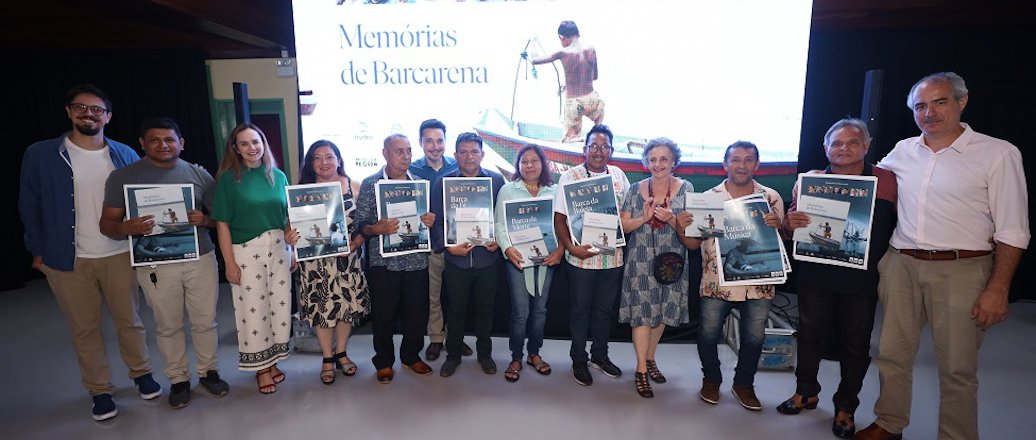A rich history told through the eyes of those who lived it, glorifying the tradition, culture, and life of the people of Barcarena. That's the aim of the “Memórias de Barcarena” project, an initiative by Hydro, Albras, and the Hydro Sustainability Fund (HSF). To tell these stories, a book, documentary, and digital exhibition were launched in Barcarena on November 29.
The book will be distributed for free in schools, libraries, and community centers in the region. The documentary is available at https://l1nk.dev/c4WI0, and the digital exhibition can be visited at https://www.memoriasdebarcarena.com.br/.
Carried out by the Museu da Pessoa and supported by the IBS (Barcarena Sustainable Initiative), the project celebrates the diversity of Barcarena society and recovers memories of former residents, including descendants of founders, indigenous people, quilombolas, and riverine communities, adding community perspectives to the town's narrative and showcasing the rich identity and nuances of its people.
In the book, 15 residents narrate everything from the eternal mysteries of the Amazon to the tangible evolution of the local economy, portraying current Barcarena as a mix of the modern and the ancient, industrial and artisanal, blending indigenous, black, and white influences.
“We aimed to represent Barcarena through the experiences of its inhabitants. We selected 15 characters from various sectors of the local community. With over 30 hours of recording, we organized the books into nine 'barcas,' each with different themes, from the city's chronological evolution to explanations of why Barcarena is such a diverse and plural municipality today,” explains Eduardo Valente, director of management and operation at Museu da Pessoa.
“This project has been a long journey, started in 2019 but paused due to the pandemic. Seeing it now being implemented by everyone is a reason to celebrate. Hydro and Albras are part of this story, as we have been here for over 30 years, and this legacy, of the people, will be known to all generations,” shares Milene Maués, manager of partnerships at HSF.
One such story is that of Antonio Palheta dos Santos, an electrician and representative of the Catholic community of Vila do Conde, born in 1957. He remains a key organizer of the village's religious festivities, including the Círios de São Francisco Xavier and São João Batista, the most important in the region.
“I heard many stories. There was no television, no radio, no cell phone. What was our pastime? Our parents, the older people gathered, and the legends came. My mother said where we lived there was a crossroads no one could pass after midnight because something always appeared that haunted people. They called it ‘visagem’. She saw these things in the woods,” recounts Antonio.
Thanks to the meticulous work of Museu da Pessoa, cataloging these memories has become possible, telling an intriguing story full of courage and vivacity, a tribute to the people of Barcarena.
“My grandmother said that here, on this land (where the Cabana Clube in Barcarena is now located), there used to be many hangings. There was a samauma tree, and that's where they tied the rope. Who knows, maybe we're on top of some grave of a soldier who fought in the Cabanagem? The workers even fear staying here alone, because they see a lot of ‘visagem’. They tell of hearing chairs being dragged and seeing many souls, white shadows, people walking. When they pay attention, it's nobody, the person disappears,” shares Mário Assunção do Espírito Santo, a 48-year-old native of the Gibrié de São Lourenço quilombo, one of the largest in Barcarena, on land registered since 1709. Mário is a pedagogue and a leading figure in the preservation and respect for indigenous and Afro-descendant communities in Barcarena, fighting for environmental conservation and recognition of traditional land ownership.
“For a long time, Barcarena only had a few small villages, a few families living in Conde, Itupanema, São Francisco. Those were the centers. There in Conde, there in São Lourenço, we must have been about fifteen families. But with the arrival of the projects, everything changed. People came from various places. It was a good period for employment. I myself worked as a mason, and I was able to provide an education for my children,” tells Valter dos Santos Freitas, better known as Mestre D’Bubuia, born in the Gibrié de São Lourenço quilombo, on the banks of the rivers of Barcarena. A fisherman since childhood, he decided in the 1990s to translate his Amazonian and quilombola experiences into the strings of the banjo, becoming a master of carimbó, and preparing his first record.
Another famous character in the book is Ronny Nascimento, one of the sons of the Ilha das Onças, in Barcarena, and a disciple of the master of guitarrada, Vieira. After being a soccer player, he became a renowned artist, releasing six vinyl records and five CDs since the 1980s. He is the composer of one of his city's symbols, the “Samba de Barcarena”. “Everyone is enchanted with the project and feeling valued, and even more, our beloved Barcarena is valued,” Ronny says emotionally.
SERVICE
“Memórias de Barcarena” Project
Documentary: https://l1nk.dev/c4WI0
Digital Exhibition: https://www.memoriasdebarcarena.com.br/
: December 1, 2023







